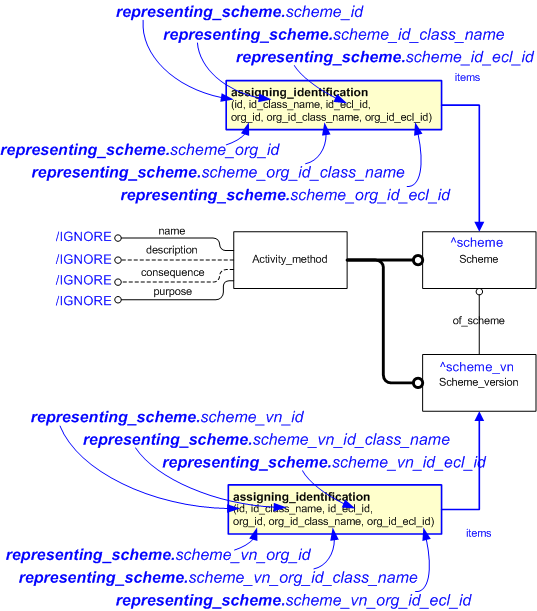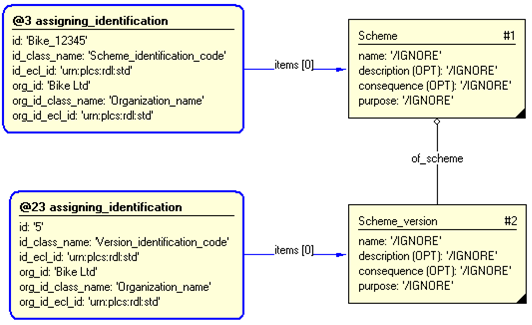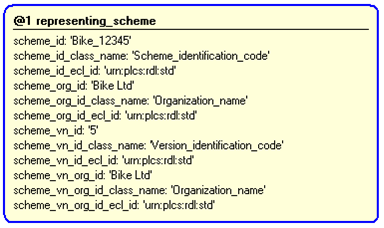Template:— representing_scheme (rep_scheme)
Capability:representing_scheme |
Date: 2008/04/21 06:28:34
Revision: 1.1
|
This section specifies the template representing_scheme.
NOTE
The template has been defined in the context of the capability
representing_scheme
which provides an overall description of the
relevant parts of the ISO 10303-239 information model and a description
of related templates.
NOTE
An explanation of a template and the associated instantiation path is
provided in the
Template overview
section.
This template describes how to represent a Scheme by its scheme and version identification.
The EXPRESS-G diagram in
Figure
1
shows the templates and EXPRESS entities that are required
to represent the template
"representing_scheme".
The text highlighted in blue shows the template parameters.
Figure 1 — An EXPRESS-G representation of the Information model for representing_scheme
The graphic for the template to be used in other EXPRESS-G diagrams
is shown in Figure
2
below.
Figure 2 — The graphical representation of the representing_scheme template
The following input parameters are defined for this template:
The identification of the
Scheme.
The name of the
External_class that determines the type of identifier given by the
input parameter @scheme_id.
The following classes and their sub-classes can be used:
The name of the
External_class that determines
the type of organization identification (@scheme_org_id) being used. For example CAGE code.
The following classes and their sub-classes can be used:
The name of the
External_class that determines the type of identifier given by the
input parameter @scheme_vn_id.
The following classes and their sub-classes can be used:
The name of the
External_class that determines
the type of organization identification (@scheme_vn_org_id) being used. For example CAGE code.
The following classes and their sub-classes can be used:
The following reference parameters are defined for this template:
Allow the
Scheme
entity instantiated in this path to be referenced when this template is used.
Note: The
Scheme
entity can be referenced in a template path by:
%^target = $representing_scheme.scheme%
where
target
is the parameter to which the
Scheme
is bound.
Allow the
Scheme_version
entity instantiated in this path to be referenced when this template is used.
Note: The
Scheme_version
entity can be referenced in a template path by:
%^target = $representing_scheme.scheme_vn%
The following parameter combinations specify a uniqueness constraint:
Unique constraint: Unique scheme
This rule means that there can be only one scheme
(
Scheme)
with any given identifier.
Unique constraint: Unique scheme version
Each instance of the
entity
(
Scheme_version)
within the data set shall be uniquely identified
by a combination of the following parameters on this
template (representing_scheme) namely:
scheme_id,
scheme_id_class_name,
scheme_id_ecl_id,
scheme_org_id,
scheme_org_id_class_name,
scheme_org_id_ecl_id,
scheme_vn_id,
scheme_vn_id_class_name,
scheme_vn_id_ecl_id,
scheme_vn_org_id,
scheme_vn_org_id_class_name,
scheme_vn_org_id_ecl_id.
The
instance is
referenced by the following template parameter:
scheme_vn.
This rule means that there can be only one version
(
Scheme_version)
of a scheme
(
Scheme)
with any given identifier.
The instantiation path shown below specifies the entities that are to be
instantiated by the template.
A description of templates and the syntax for the instantiation path is
provided in the
Templates Help/Information section.
Scheme%^scheme =
Scheme%
Scheme.name = '/IGNORE'
Scheme.description = '/IGNORE'
Scheme.consequence = '/IGNORE'
Scheme.purpose = '/IGNORE'
-- Identify the Scheme /
assigning_identification(
items=^scheme,
id=@scheme_id,
id_class_name=@scheme_id_class_name,
id_ecl_id=@scheme_id_ecl_id,
org_id=@scheme_org_id,
org_id_class_name=@scheme_org_id_class_name,
org_id_ecl_id=@scheme_org_id_ecl_id )/
-- Scheme version Scheme_version%^scheme_vn =
Scheme_version%
Scheme_version.name = '/IGNORE'
Scheme_version.description = '/IGNORE'
Scheme_version.consequence = '/IGNORE'
Scheme_version.purpose = '/IGNORE'
-- Identify the Scheme_version /
assigning_identification(
items=^scheme_vn,
id=@scheme_vn_id,
id_class_name=@scheme_vn_id_class_name,
id_ecl_id=@scheme_vn_id_ecl_id,
org_id=@scheme_vn_org_id,
org_id_class_name=@scheme_vn_org_id_class_name,
org_id_ecl_id=@scheme_vn_org_id_ecl_id )/
The following entities are instantiated with attributes as specified:
The instance diagram in Figure
3
shows an example of the EXPRESS entities and templates that are instantiated by the template:
/representing_scheme(scheme_id='Bike_12345', scheme_id_class_name='Scheme_identification_code', scheme_id_ecl_id='urn:plcs:rdl:std', scheme_org_id='Bike Ltd', scheme_org_id_class_name='Organization_name', scheme_org_id_ecl_id='urn:plcs:rdl:std', scheme_vn_id='5', scheme_vn_id_class_name='Version_identification_code', scheme_vn_id_ecl_id='urn:plcs:rdl:std', scheme_vn_org_id='Bike Ltd', scheme_vn_org_id_class_name='Organization_name', scheme_vn_org_id_ecl_id='urn:plcs:rdl:std')/
(an illustration of the consolidated representing_scheme template is shown in
Figure
4 below.)
Figure 3 — Entities instantiated by representing_scheme template
The instance diagram in
Figure
4
shows the graphic symbol for the template that is to be
used in other instance diagrams. The example template is:
/representing_scheme(scheme_id='Bike_12345', scheme_id_class_name='Scheme_identification_code', scheme_id_ecl_id='urn:plcs:rdl:std', scheme_org_id='Bike Ltd', scheme_org_id_class_name='Organization_name', scheme_org_id_ecl_id='urn:plcs:rdl:std', scheme_vn_id='5', scheme_vn_id_class_name='Version_identification_code', scheme_vn_id_ecl_id='urn:plcs:rdl:std', scheme_vn_org_id='Bike Ltd', scheme_vn_org_id_class_name='Organization_name', scheme_vn_org_id_ecl_id='urn:plcs:rdl:std')/
Figure 4 — Instantiation of representing_scheme template
Characterizations
No common characterizations of the template
representing_scheme
have been identified. However, the ISO 10303-239 EXPRESS model
may enable other assignments to the entities instantiated by the template.




